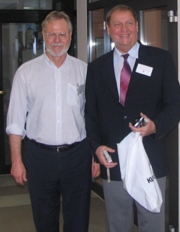Abstract of my Dissertation (nur in Englisch)
A practice-oriented procedure for engineering time estimation of industrial plant design for small and medium enerprises
My dissertation presents a procedure that can help technology managers to reason about engineering effort. Among some basic project planning issues, a new activity based time keeping method, a method to estimate the project status, and a semi- parametric method to estimate engineering design effort are being presented. The semi- parametric method contains twelve influence factors, five effort drivers and one size driver. Data was collected from five engineering design orders to define, calibrate and test the procedure.
The dissertation is divided into ten chapters:
Chapter 1 deals with the problem definition and the aims of this work. The requirements for the new engineering time estimation procedure will be defined. The new procedure has been developed to provide certain features. Among these is to provide a well defined and pragmatic procedure that is accurate but simple, tailor able to enable ways for individual organizations to adjust the procedure, and finally parsimonious to avoid use of redundant factors or factors which make no contribution to the results.
Chapter 2 is dedicated to the theses of the dissertation. The central proposition at the core of this research is that it is not possible to calculate the nominal engineering effort by use of a parametric equitation alone. Nevertheless, a semi-parametric method will help to adjust the nominal engineering effort to the project’s complexity and to the dynamics of the environment. The term semi-parametric implies that the equation will represent a function that is characteristic of effort drivers and stochastic influence factors.
Chapter 3 is devoted to the engineering design environment. In the context of this dissertation engineering design encompasses disciplines such as electrical engineering, mechanical engineering, and informatics. Engineering design enables the creation of industrial plants of different size and complexity.
Engineering design is seen as an interdisciplinary process to ensure that the stakeholder needs are satisfied in a high quality, trustworthy, cost efficient and schedule compliant manner. Part of the complexity with engineering design is due to the diversity of companies and products in which engineering design is utilized in practice.
It is important to understand the environment, because all influence factors are obviously depending on the environment.
In Chapter 4, 5 and 6 the basics of project planning, time estimation, and project controlling will be discussed. An important part of developing a new engineering effort estimation procedure is recognizing previous work in related areas.
A number of engineering estimation techniques are currently in use by practitioners. They vary in both maturity and sophistication.
Heuristic reasoning and expert opinion has been commonly used by engineers to arrive at quick answers. Expert opinion is useful in the absence of empirical data and it is very simple. The obvious drawback is that an estimate is only as good as the expert’s opinion, which can vary greatly from person to person.
The Bottom-Up approach involves identifying and estimating costs of individual project components separately and subsequently combining the outcomes to produce an estimation for the overall project. The bottom-up method assumes the availability of cost information for single engineering tasks. The method capitalizes on experience and standardization of an organization. It can contribute to a fairly accurate estimate at the nominal estimation.
A wealth of models and processes exist in the area of software engineering. Parametric cost estimation is the most sophisticated method.
Chapter 7 is dedicated to the research of influence factors and effort drivers. The scope of this chapters is to identify the relevant parameters in engineering design effort estimation while building on the lessons learned in neighboring engineering disciplines.
The identification and metrics of stochastic influence factors and effort drivers is pivotal. The influence factors and effort drivers were defined after extensively surveying recent engineering literature. Influence factors are stochastic while effort drivers depend on complexity. Each rating level of each size driver is associated to a weight. Effort drivers will be used to adjust the nominal effort to an engineering task’s complexity.
Chapter 8 will deal with an explorative research of executed engineering design orders. A number of examples will be scrutinized in the search of time consuming engineering activities and common problems. These data will be used to check and calibrate the new procedure.
In Chapter 9 a new activity based time keeping method, a method to estimate the project status, and a semi- parametric method to estimate engineering design effort are being presented. The new procedure shares commonalities with existing approaches in adjacent engineering disciplines.
The equitation to adjust the nominal estimation to the dynamics and complexity of an engineering design order contains three different types of parameters: additive, multiplicative, and exponential. Nominal effort is additive. Influence factors are multiplicative because they all have global effects across the overall system. Influence factors are used to adjust to the dynamics of the environment. Effort drivers are exponential because they have both a global effect and an emergent effect for larger projects. Effort drivers are used to adjust to the complexity level of the requirements.
In Chapter 10 the theses will be validated. The usability of the new procedure will be proofed using the examples of the explorative research in chapter 8. The central proposition will be validated through the use of research and analysis of data.The contributions of this dissertation to science and practice can be found in the search of a more quantitative cost estimation framework and in advancing the state of practice in the assessment of engineering design effort.
Key Words:
Engineering Time Estimation, Effort Drivers, Stochastic Influence Factors, Semi-Parametric Procedure, Sensitivity Analysis, Activity based Time Keeping Method, Engineering Design
Letzte Aktualisierung am 28.12.2014





Connect with me
Mobile Phone +49 176 97 873 726
Email: steck-winter@gmx.de
Email: hartmut.steck-winter@live.de